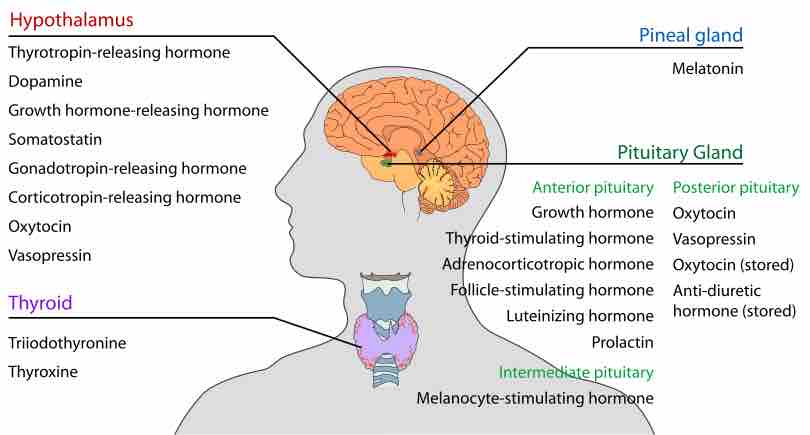Endocrine glands are ductless and release their secretions directly into the intercellular fluid or into the blood. A collection of endocrine glands makes up the endocrine system: the pituitary (anterior and posterior lobes), thyroid, parathyroid, adrenal (cortex and medulla), pancreas and gonads.

Endocrine glands in the human head and neck
The endocrine system is the system of glands, each of which secretes different types of hormones directly into the bloodstream (some of which are transported along nerve tracts) to regulate the body.
Pituitary Gland
The hypothalamus makes up the lower region of the diencephalons and lies just above the brain stem. The pituitary gland (hypophysis) is found in the inferior part of the brain, attached to the bottom of the hypothalamus by a slender stalk called the infundibulum.
The pituitary gland consists of two major regions, the anterior pituitary gland (adenohypophysis) and the posterior pituitary gland (neurohypophysis). The hypothalamus also controls the glandular secretion of the pituitary gland.
Posterior Pituitary Gland
Communication between the hypothalamus and the posterior pituitary occurs through neurosecretory cells that span the short distance between them. Hormones produced by the cell bodies of the neurosecretory cells are packaged in vesicles and transported through the axon and stored in the axon terminals that lie in the posterior pituitary.
When the neurosecretory cells are stimulated, the action potential generated triggers the release of the stored hormones from the axon terminals to a capillary network within the posterior pituitary. Two hormones—oxytocin and antidiuretic hormone (ADH)—are produced and released this way.
Anterior Pituitary Gland
The anterior pituitary is involved in sending hormones that control all other hormones of the body. Its lobe is derived from oral ectoderm and is composed of glandular epithelium.
Communication between the hypothalamus and the anterior pituitary occurs through hormones (releasing hormones and inhibiting hormones) that are produced by the hypothalamus and delivered to the anterior pituitary via a portal network of capillaries. The releasing and inhibiting hormones are produced by specialized neurons of the hypothalamus called neurosecretory cells.
These hormones are released into a capillary network that supplies the anterior pituitary. The hormones then diffuse from this secondary plexus into the anterior pituitary, where they initiate the production of specific hormones by the anterior pituitary.
Thyroid Gland
This is one of the largest endocrine glands in the body. It is positioned on the neck just below the larynx and has two lobes, one on either side of the trachea.
It is involved in the production of the hormones T3 (triiodothyronine) and T4 (thyroxine). These hormones increase the metabolic activity of the body‘s cells.
The thyroid also produces and releases the hormone calcitonin (thyrocalcitonin) that contributes to the regulation of blood calcium levels. Thyrocalcitonin or calcitonin decreases the concentration of calcium in the blood, where most of it is stored in the bones.
Parathyroid
There are four parathyroid glands, all located on the thyroid gland. One of its most important functions is to regulate the body's calcium and phosphorus levels.
All four glands also secrete parathyroid hormone, or PTH, which causes calcium to be released from the bones back into the extracellular fluid. PTH is released directly into the bloodstream and travels to its target cells, which are often quite far away and found in bone, kidneys, and the gastrointestinal system.
Calcitonin, a hormone produced by the thyroid gland that also regulates ECF calcium levels, serves to counteract the calcium-producing effects of PTH.
Adrenal Glands
The adrenal glands are a pair of ductless glands located above the kidneys. Through hormonal secretions, they regulate many essential bodily functions including biochemical balances that influence athletic training and general stress response.
The glucocorticoids include corticosterone, cortisone, and hydrocortisone or cortisol. These hormones serve to stimulate the conversion of amino acids into carbohydrates, a process known as gluconeogenesis, and the formation of glycogen by the liver. They also stimulate the formation of reserve glycogen in the tissues, such as in the muscles.
Adrenal glands
These are responsible for releasing hormones in response to stress through the synthesis of corticosteroids such as cortisol, and catecholamines such as epinephrine (adrenaline) and norepinephrine.
Pancreas
The pancreas is a very important organ in the digestive and the circulatory systems that helps to maintain our blood sugar levels. It is considered to be part of the gastrointestinal system since it produces digestive enzymes. These are released into the small intestine to aid in reducing food particles to basic elements that can be absorbed by the intestine and used by the body.
It has another, very different function in that it forms insulin, glucagon, and other hormones that are sent into the bloodstream to regulate blood sugar levels and other activities throughout the body.